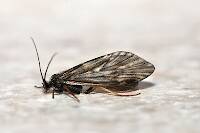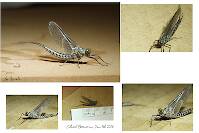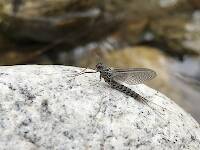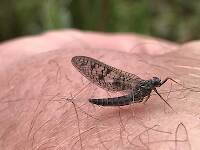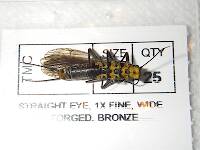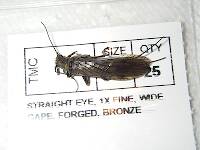
Blue-winged Olives
Baetis
Tiny Baetis mayflies are perhaps the most commonly encountered and imitated by anglers on all American trout streams due to their great abundance, widespread distribution, and trout-friendly emergence habits.
Featured on the forum

This wild-looking little thing completely puzzled me. At first I was thinking beetle or month larva, until I got a look at the pictures on the computer screen. I made a couple of incorrect guesses before entomologist Greg Courtney pointed me in the right direction with Psychodidae. He suggested a possible genus of Thornburghiella, but could not rule out some other members of the tribe Pericomini.

Troutnut is a project started in 2003 by salmonid ecologist Jason "Troutnut" Neuswanger to help anglers and
fly tyers unabashedly embrace the entomological side of the sport. Learn more about Troutnut or
support the project for an enhanced experience here.
JOHNW on May 14, 2011May 14th, 2011, 5:46 pm EDT
OK so last year during the sulphurs I fell in love with this pattern tied on a Partridge 15BN for fussy fish.
Now as I am gearing up for the big bug time of year I'm trying to figure out the materials for a green drake version. I think I have the thorax, hackle and wing down however the abdomen is proving a challenge. The biggest problem is deciding on the color vs. proportion thing.
For the sulphurs and smaller mayflies I just use mayfly brown staight z-lon and spin it tight and then wrap. However on the drake sized hook (subbing a #8 TMR 200R for the partridge) this leaves tha abdomen rediculously skinny as compared to the real thing and the rest of the fly.
Any suggestions?
JW
Now as I am gearing up for the big bug time of year I'm trying to figure out the materials for a green drake version. I think I have the thorax, hackle and wing down however the abdomen is proving a challenge. The biggest problem is deciding on the color vs. proportion thing.
For the sulphurs and smaller mayflies I just use mayfly brown staight z-lon and spin it tight and then wrap. However on the drake sized hook (subbing a #8 TMR 200R for the partridge) this leaves tha abdomen rediculously skinny as compared to the real thing and the rest of the fly.
Any suggestions?
JW
"old habits are hard to kill once you have gray in your beard" -Old Red Barn
Taxon on May 14, 2011May 14th, 2011, 10:14 pm EDT
Hi John-
Based on your location, I will assume you are interested tying a Quigley Cripple pattern to imitate an emerging Ephemera guttulata nymph whose subimaginal abdomen is stuck in (or has not yet been withdrawn from) its nymphal abdomen, which looks like this:

So, were it me, I would probably use medium tan marabou counter-wrapped with ribbing of light tan thread, or perhaps gold wire for increased durability.
Based on your location, I will assume you are interested tying a Quigley Cripple pattern to imitate an emerging Ephemera guttulata nymph whose subimaginal abdomen is stuck in (or has not yet been withdrawn from) its nymphal abdomen, which looks like this:

So, were it me, I would probably use medium tan marabou counter-wrapped with ribbing of light tan thread, or perhaps gold wire for increased durability.
JOHNW on May 15, 2011May 15th, 2011, 10:24 am EDT
Thanks Roger!
I suppose I should have been a little more clear on exactly which Green Drake I was referring to; fortunatly your powers of deduction are spot on.
That seems like it would be the ticket.
JW
I suppose I should have been a little more clear on exactly which Green Drake I was referring to; fortunatly your powers of deduction are spot on.
That seems like it would be the ticket.
JW
"old habits are hard to kill once you have gray in your beard" -Old Red Barn
Quick Reply
Related Discussions
Topic
Replies
Last Reply
4
Jun 17, 2020
by Leskorcala
by Leskorcala
6
Jun 10, 2009
by Martinlf
by Martinlf
Re: Best of the Forum--Most Useful and Informative Bug Threads Featured Topic
In General Discussion by Martinlf
In General Discussion by Martinlf
17
Feb 26, 2016
by Crepuscular
by Crepuscular
4
May 2, 2010
by SlateDrake9
by SlateDrake9




